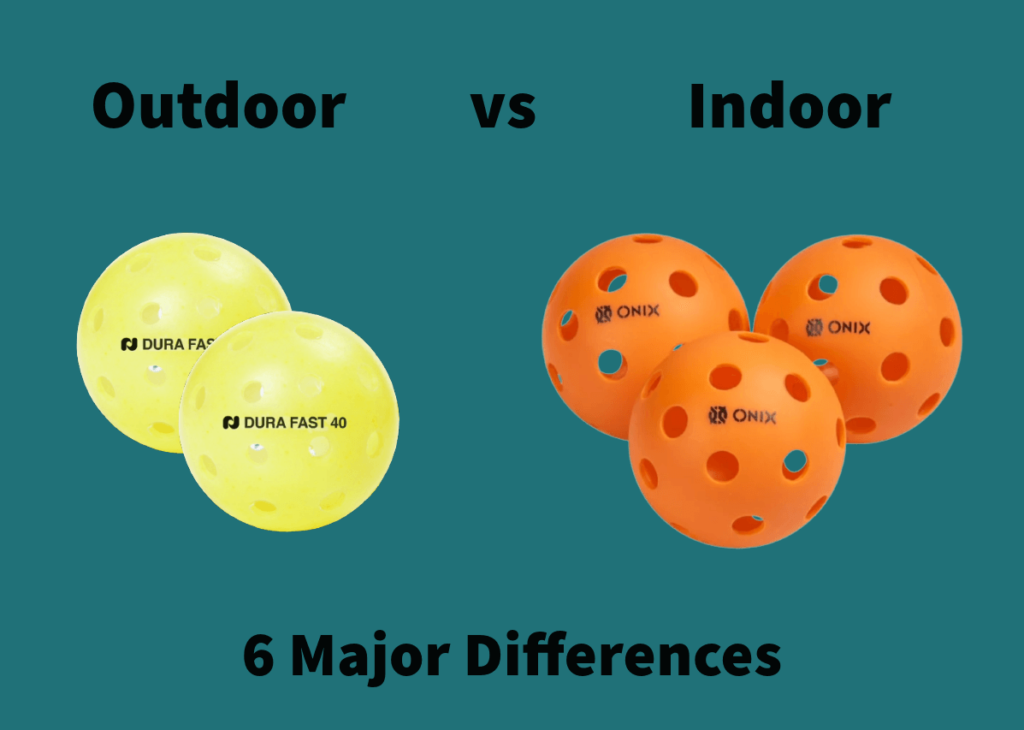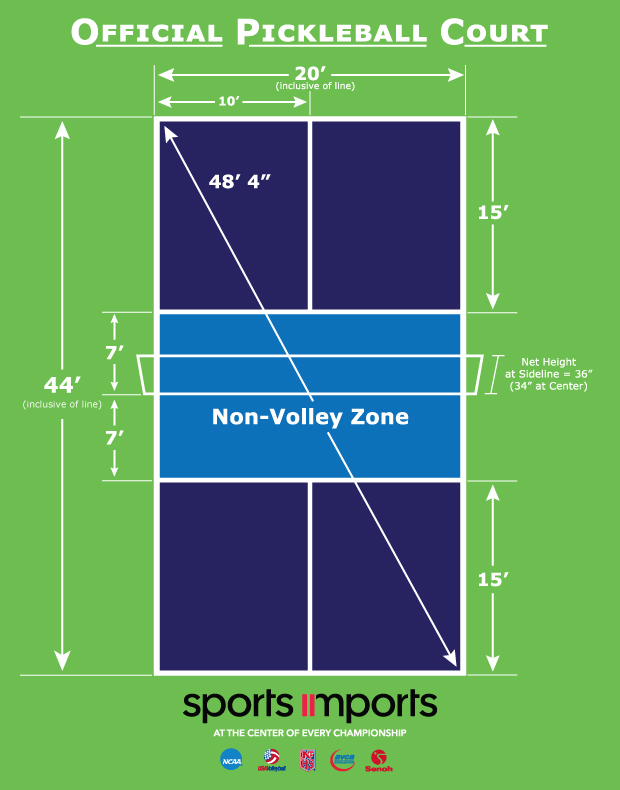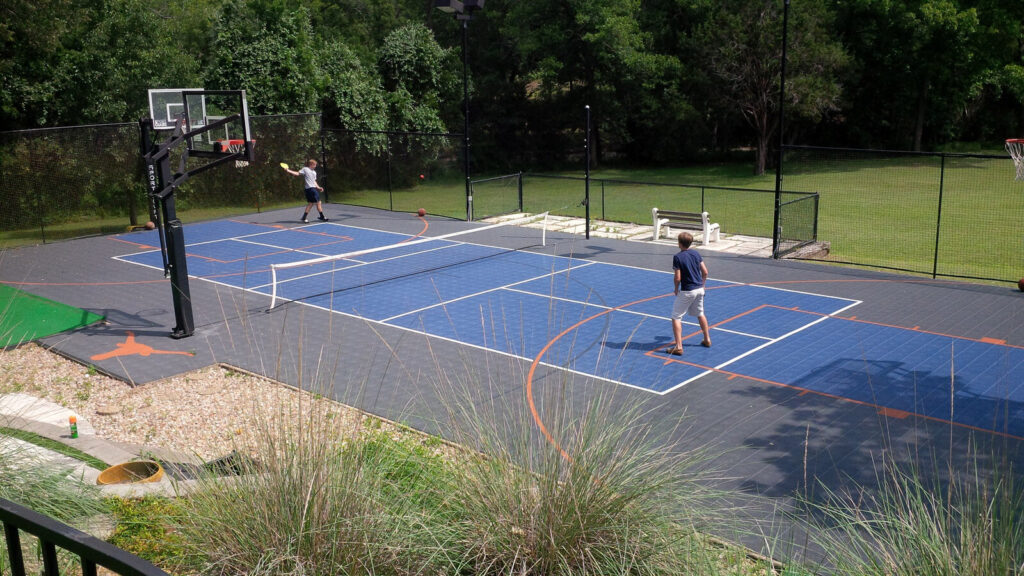Indoor pickleballs are made from a softer plastic, while outdoor pickleballs are made from a harder, more durable material. The difference in materials affects the weight, bounce, and overall performance of the balls in different playing environments.
Pickleball is a popular sport that can be played both indoors and outdoors. However, the type of pickleball used can vary depending on the playing environment. Indoor pickleballs are made from a softer plastic material, while outdoor pickleballs are made from a harder, more durable material.
This difference in materials has a significant impact on the weight, bounce, and overall performance of the balls. We will explore the distinctions between indoor and outdoor pickleballs, highlighting how they affect gameplay and player experience. Whether you’re a seasoned pickleball player or new to the game, understanding these differences will help you choose the right pickleballs for your playing environment.

Credit: www.justpaddles.com
Physical Differences
Pickleballs are designed with specific characteristics to suit the playing environment, whether it’s indoors or outdoors. The physical differences between indoor and outdoor pickleballs can significantly impact their performance and durability. Let’s delve into the distinct features of indoor and outdoor pickleballs to understand their unique qualities.
Color
Indoor pickleballs are typically bright yellow, while outdoor balls can be yellow, green, or orange. The brighter colors of outdoor balls help make them more visible in different lighting conditions.
Weight
Outdoor pickleballs are heavier and more durable, designed to withstand rougher surfaces, wind, and elements. In contrast, indoor pickleballs are lighter, providing a gentler touch when hit.
Material
Indoor pickleballs are often a bit softer, offering a more forgiving bounce and gentle contact with the racquet. Outdoor balls, on the other hand, are constructed with more durable materials to endure the demands of outdoor play, including wind and rough surfaces.

Credit: www.paddletek.com
Functional Differences
Indoor and outdoor pickleballs have key differences. Outdoor pickleballs are heavier and durable to withstand rough surfaces and wind, while indoor pickleballs are lighter and have larger holes for a softer touch during play. Additionally, color variation helps improve visibility, with indoor balls usually being brighter yellow and outdoor balls available in yellow, green, or orange.
Durability
When it comes to durability, there is a notable difference between indoor and outdoor pickleballs. Outdoor pickleballs are specifically designed to withstand rough surfaces, wind, and the elements. They are made with stronger materials, such as a harder plastic shell, which makes them more resistant to cracks and breakage. This durability factor ensures that outdoor pickleballs can endure the wear and tear of outdoor play and last longer in comparison to indoor ones.
On the other hand, indoor pickleballs are lighter and have a softer construction. They are primarily used for play on indoor courts with smoother surfaces. The materials used in indoor pickleballs are gentler, which gives players a more delicate touch when hitting the ball. While indoor pickleballs may not be as durable as their outdoor counterparts, their softer construction helps to prevent damage to the paddle and reduce the risk of injuries during play.
Visibility
Visually distinguishing the pickleball during gameplay is crucial. Indoor and outdoor pickleballs differ in terms of their color and visibility. Indoor pickleballs are typically bright yellow, while outdoor balls can come in yellow, green, or orange. The brighter colors used for outdoor pickleballs help enhance their visibility in varying lighting conditions.
During outdoor play, the natural lighting can sometimes create shadows or glare, making it more challenging to track the ball’s movement. The vibrant colors of outdoor pickleballs make them more visible against different backgrounds, ensuring players can easily follow the trajectory of the ball. Indoor pickleballs, with their bright yellow color, are optimized for visibility in indoor environments with controlled lighting conditions.
Wind Resistance
Wind resistance is a significant factor that sets outdoor and indoor pickleballs apart. Due to their heavier construction and firmer plastic shell, outdoor pickleballs are more resistant to wind. This attribute ensures that the ball’s flight is not easily affected by gusts of wind, providing a more consistent and predictable gameplay experience.
Indoor pickleballs, being lighter and softer, are not as wind-resistant as their outdoor counterparts. Their lighter weight makes them more susceptible to wind disruptions, which can alter the ball’s trajectory and cause unpredictable bounces. Therefore, indoor play is typically conducted in enclosed areas where wind interference is minimized, ensuring a smoother and more controlled game.
Choosing The Right Pickleballs
Indoor and outdoor pickleballs have distinct differences. Indoor pickleballs are typically softer and lighter, offering a gentler touch. Outdoor pickleballs, on the other hand, are heavier and more durable to withstand rough surfaces and weather conditions.
Considerations
When it comes to choosing the right pickleballs, there are a few considerations to keep in mind. Whether you are playing indoors or outdoors, the type of pickleball you use can greatly impact your gameplay. Here are some factors to consider when selecting the right pickleballs for your game.Personal Preference
Your personal preference plays a significant role in choosing the right pickleballs. Some players enjoy the softer feel of indoor pickleballs, while others prefer the firmer bounce of outdoor pickleballs. It is important to consider your own playing style and what feels most comfortable for you. Trying out different types of pickleballs can help you determine your personal preference.Weight
Weight is another crucial factor to consider when selecting pickleballs. Outdoor pickleballs are typically heavier and more durable, designed to withstand rough surfaces, wind, and other outdoor elements. On the other hand, indoor pickleballs are lighter, allowing for better control and a gentler touch when you hit them. The weight of the pickleball can greatly affect your gameplay, so choose the weight that suits you best.Color
The color of the pickleball is also important to consider. Indoor pickleballs are usually bright yellow, while outdoor balls can come in yellow, green, or orange. The brighter colors of outdoor pickleballs help make them more visible in different lighting conditions, especially when playing outdoors. Visibility during play is crucial, so choose a color that stands out and makes it easier for you to track the ball. In conclusion, choosing the right pickleballs is crucial for optimizing your gameplay. Consider your personal preference, weight, and color when selecting indoor or outdoor pickleballs. It’s all about finding the right fit for your playing style and maximizing your enjoyment on the pickleball court.
Credit: mypickleballgear.com
Frequently Asked Questions For Difference Between Indoor And Outdoor Pickleballs
How To Tell The Difference Between Indoor And Outdoor Pickleballs?
Indoor pickleballs are typically bright yellow, while outdoor pickleballs can be yellow, green, or orange. The brighter colors of outdoor balls help make them more visible in different lighting conditions. Additionally, indoor pickleballs are a bit softer in texture, while outdoor pickleballs are made from a harder, more durable plastic.
What Is The Difference Between Yellow And Orange Pickleballs?
The difference between yellow and orange pickleballs is their color. Indoor pickleballs are typically bright yellow, while outdoor balls can be yellow, green, or orange. The brighter colors of outdoor balls help make them more visible in different lighting conditions.
What Is The Easiest Pickleball Color To See?
The easiest pickleball color to see is typically bright yellow or green, especially in outdoor settings. These brighter colors help make the ball more visible during play. Some pickleballs may also come in orange, pink, or blue colors.
How Many Holes Do Indoor Pickleball Balls Have?
Indoor pickleball balls have 26 holes. They are made from a softer plastic material for a gentler touch.
Conclusion
Understanding the differences between indoor and outdoor pickleballs is crucial for a successful game. The choice of the ball impacts visibility, weight, and durability, which greatly affects gameplay. By considering these factors, players can optimize their performance and enjoy the game to the fullest.
Neil jacobson is an avid Pickleball enthusiast, writer, and coach dedicated to sharing the joy and intricacies of the sport. With 6 years of experience on the court and a passion for teaching, Courtney brings a unique perspective to his writing, offering practical insights and strategies for players of all levels. As a certified Pickleball coach, his mission is to inspire and empower individuals to excel in the game while fostering a sense of community within the Pickleball world. Through his articles, guides, and coaching sessions, Neil aims to elevate the playing experience and share the infectious enthusiasm that defines the Pickleball community.



